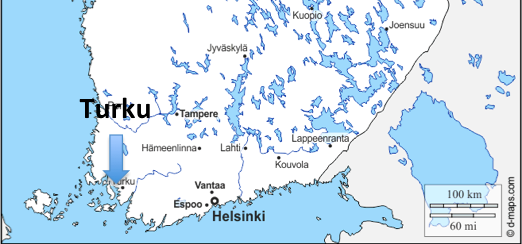
A European Journey #23 – Turku (Finland)
The Finnish Reformation
Today we are visiting Finland and in particular its historical capital, Turku.
Located in the south-western region of Finland Proper, Turku was founded at the end of the thirteenth century and is thus the oldest city of Finland. While Helsinki is the present capital of Finland, Turku remains an important city, particularly thanks to its harbour and two universities.
We are going to focus on the Turku Cathedral, which is located by the Aura River. It is surrounded by cobblestone streets and neoclassical buildings built after the dramatic Great Fire of 1827.
If we walk towards the right side of the cathedral, we discover the statue of a man named Mikael Agricola dressed in a hat and a robe. The outfit is typical to that of a Reformer. And that is exactly what Agricola turns out to be.
So as you might have guessed, we are going to talk about the Finnish Reformation of the sixteenth century. But before that, we first need to take a brief look at the political context of the time.
In the beginning of the sixteenth century, Finland had been under Swedish rule for more than three hundred years. Actually, at this time, Sweden had been a part of the Scandinavian Union, together with Denmark and Norway, for two centuries. However the Union was now at the verge of collapse.
This is when the Danish king Christian II followed the advice of the Catholic Archbishop of Uppsala, Gustav Trolle, to invade Sweden. This invasion resulted in the terrible Stockholm bloodbath of November 1520. A few months later, a Swedish rebellion was organised by a Swedish nobleman named Gustav Vasa. The war that resulted lasted until 1523, ending with the victory of the Swedes.
Just a few years earlier, the Reformation had started in Wittenberg and quickly spread among Northern Germanic lands. The strong presence of German merchants in Sweden and Finland contributed to the quick spread of the Gospel there. Obviously, the recent events had created a rift between Gustav Vasa and the Catholic Church. This contributed to the adoption of the Reformation by the new king Gustav Vasa.
This favourable disposition towards the Reformation had repercussions in Finland.
Mikael Agricola has often been called The Finnish Luther, and this for obvious reasons, as I’ll explain in more detail. However, he was not alone in the process. Two other people played a crucial role in the Finnish Reformation as well in paving the way for Agricola’s work.
The first one, Pietari Särkilahti is the first known Finnish cleric to have adopted and preached Reformed theology. Being the son of the city mayor, Särkilahti studied in Rostock (Germany), Leuven (Belgium) and probably Wittenberg (Germany). He then returned to Turku in 1524 and preached the Evangelical Lutheran faith until his death five years later.
The second one was a Dominican monk named Mårten Skytte who was appointed bishop of Turku by Gustav Vasa in 1528. During his term of twenty-two years, Skytte sent many young talented Finnish people to study at the feet of Luther and Melanchthon in Wittenberg. It was also during his office, in 1537, that the language of the mass was changed from Latin into Finnish.
And so, Mikael Agricola was actually the third figure of the Finnish Reformation. Born on the southern coast near modern-day Helsinki, he attended school at Viipuri (today Vyborg, under Russian control) before moving to Turku in 1528.
That is where he came in touch with Särkilahti’s preaching. These sermons had a profound influence on him. Mårten Skytte identified his talent, and sent him to Wittenberg in 1536. After receiving his MA, he returned to Finland in 1539 and went on to become the most influential Reformer of Finnish history.
What did he do that so transformed his nation?
Agricola is not only known as the Reformer of Finland, but also as the Father of Finnish literature. He created the Finnish alphabet and was the first to write works in Finnish, such as a Grammar book for children (ABC kirja – 1543), a Biblical prayer book of 900 pages (containing passages of the Bible, writings from the Church Fathers, medieval authors and reformers) and many other works.
When the war broke out between Russia and Sweden, Gustav Vasa sent Agricola to Russia to negotiate a peace treaty. Sadly, while travelling back, Agricola fell ill and died on a boat in the Karelian Isthmus.
The Finnish Reformation differed from others in that the transition from Catholicism to Protestantism was relatively peaceful. The Finnish Roman Catholic church was not as decadent as elsewhere. Contrary to Germany, Finnish reformers also allowed other expressions of Christianity to subsist. To this day, Finland is recognized for its tolerance towards different expressions of Christianity.
Without Agricola’s work, the Finnish language could even have been wiped out. Agricola thus paved the way for the Finnish independence nearly four centuries later.
See you next week somewhere else in Europe.
Cédric Placentino
Schuman Centre convener for Italian and French Europe
Follow A European Journey here.

This Post Has 0 Comments